|

The location of the works. |
Background
The Wolverhampton Gas Light Company built
Wolverhampton’s first gas works at Horseley Fields. It
opened on 17th September, 1821 to supply gas for street
lighting. A description of the works can be found in
Part 5.
| Read about
Horseley Fields Gas Works |
 |
Within a few years more street
lights were added, as the gas supply was extended to outlying areas. Houses and factories were also lit by gas, and
by 1849 pipes had been laid in Penn Road and Tettenhall
Road.
In the late 1840s Horseley Fields
works struggled to cope with the rising demand, and so a
piece of land was acquired for the building of a new,
larger, gas works in Stafford Road, along the western
side of the canal.
|
|
In 1849 when the new gas works was
built, the canal played an essential role. Coal arrived by narrow boat, and
by-products such as coal gas tar were transported by narrow boats to
local manufacturers such as Midland Tar Distillers
Limited at Monmore Green, already covered in Part 1.
|
| |
|
| Read about Midland Tar
Distillers Ltd. |
 |
| |
|
| In the mid 1860s Wolverhampton Corporation
decided to purchase the gas company, but the asking price was far too
high. In the early 1860s John Annan from Perth, became second
engineer to Mr. Proud at the Stafford Road works. When Proud
resigned in June 1864, Annan became Chief Engineer and Manager, and
economised the production of gas. As a result Wolverhampton became
the lowest gas-rated town in Britain. Mr. Annan
was elected to the Town Council as one of the
representatives of St. Mark's Ward in November 1883
and was Mayor of Wolverhampton from 1884 to 1885.
In 1869 the
Corporation came into conflict with the gas company.
Councillor R. Sidney informed the council that he
understood that the gas company had been using some of
its profits to extend Stafford Road works. According to
the Act of Parliament the company could only distribute
a 10 percent dividend amongst the shareholders, and must
have a reserve fund of £5,000. |
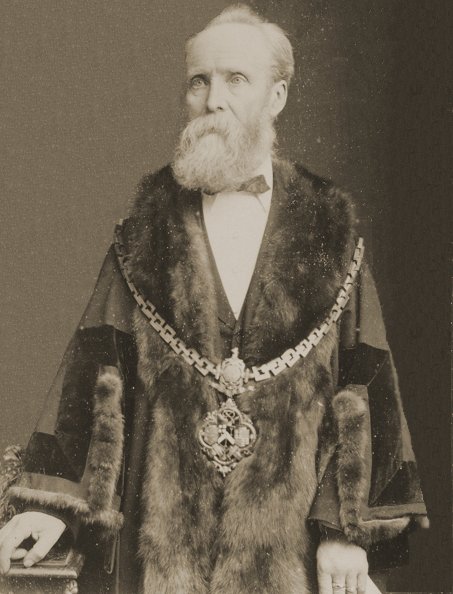
Mr. John Annan, J.P. in his
mayoral robes. |
|
After this, the balance of the profits had to
go towards reducing charges to the customers. As the Corporation was
the largest customer, it thought that it should be charged less. The company’s directors challenged the Corporation to prove its
claims. The Act of Parliament under which the gas company operated,
stated that any case of dispute between the company and its
customers should be referred to the Court of Quarter Sessions at
Stafford. Their decision on the matter would be final.
The case came up for hearing, and the verdict
was that although there were irregularities in the keeping of the
accounts, the Corporation had failed in its contention. The gas
company was ordered to deduct income tax from any future dividend
paid to its shareholders, and to keep the accounts in better form.
At the next meeting of the Town Council the committee reported that
the cost of the appeal to the Quarter Sessions was £215 and the
result would be a gain for the Corporation. The directors of the gas
company were very disappointed at the result.
Several balloon flights began at the gas works,
the most famous taking place on 5th September 1862 when Glaisher and
Coxwell reached an altitude of 37,000 feet, around 7 miles. A world
record at the time.
|
| Read about Glaisher and
Coxwell's flight |
 |
| |
|
In 1880 a new gas showroom was built in Darlington Street, on the
corner of Waterloo Road. It remained in use until 1938 when it was
replaced by the building that is there today.
The new
showroom, designed by local architects Lavender and Twentyman opened
in 1940 and became known as Clock Chambers. It survives today
as a shop and offices, and is locally listed. |
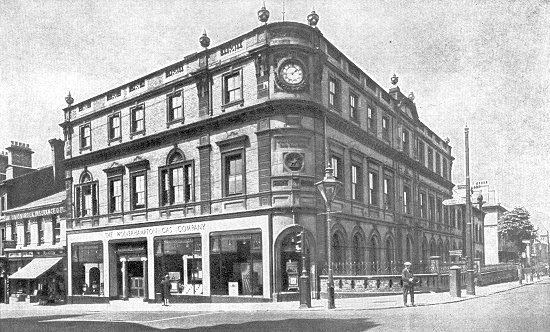
The gas showroom and
offices. |
|
In 1900 Stafford Road gas works was extended
along the opposite side of the canal, and Horseley Fields gas works
closed. The new gas works had its own canal basin in between locks
14 and 15. The gas works also had its own railway system and
industrial locomotives, with a direct link to the main lines of the
London & North Western Railway, and the Great Western Railway. Both
sides of the works were linked by a small bridge between locks 14
and 15 which carried the internal railway over the canal.
In the early 1900s the directors were A. B. Hanbury Sparrow (chairman), J. W. Tilley (vice chairman), Sam
Loveridge, Sir G. H. Holcroft, L. T. Smith, and A. Jones. The
engineer and manager was P. G. Winstanley; A. G. Williams was
company secretary. |

A view of the gas
works from the canal. The bridge on the right
is the railway bridge that linked both halves of the site. Courtesy of the late Alex Chatwin. |
|
By 1938 the company supplied 1,250,000,000
cubic feet of gas to 46,000 clients, including a large number of
local factories.
The Wolverhampton Gas Company survived until nationalisation on
1st May, 1949 when it became part of the West Midlands Gas Board,
serving Wolverhampton, Tettenhall, Wednesfield, Codsall, Lower Penn,
and Wrottesley.
|

Another view of the gas works. |
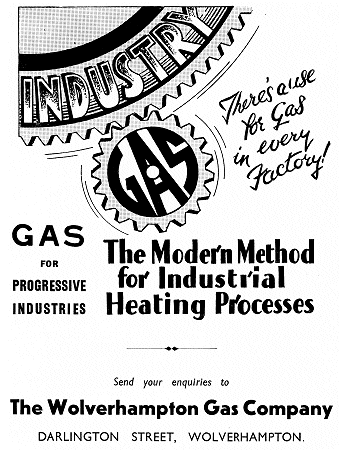
An advert from 1938.
|
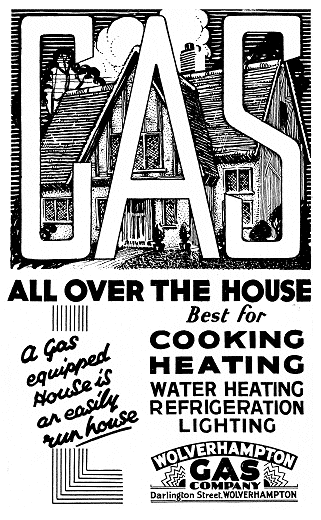
An advert from 1936. |
|

An advert from 1938. |
|
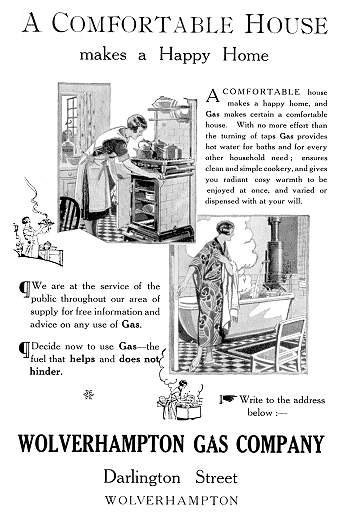
An advert from 1930. |
|
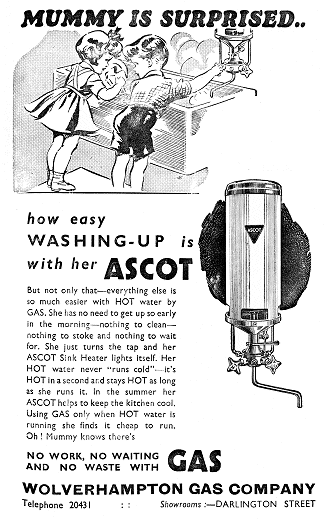
An advert from 1942. |
|

An advert from 1951. |
Stafford Road Works continued in use until 1967.
The late 1960s
saw a great change in the industry due to the conversion from town
gas to natural gas, which enabled gas users to comply with the 1956
Clean Air Act.
In 1966 the decision was taken to
convert the whole of the United Kingdom from town gas to natural
gas, and in 1967 the first natural gas arrived from the North Sea.
The area covered by the former gas works has now been redeveloped after years of
dereliction, and a large-scale clean-up and decontamination of the
site.
The eastern side is now occupied by Wolverhampton Science
Park, and the western side is an industrial estate.
|
 |
Return to the Canals
and Industry Menu |
|